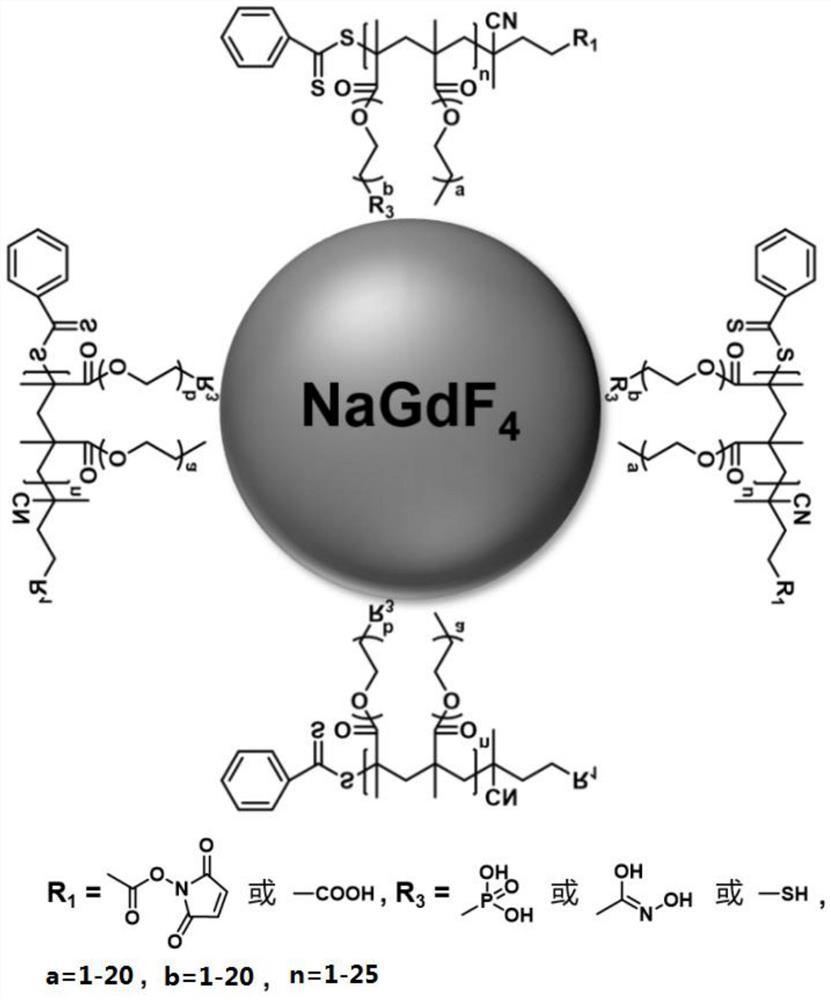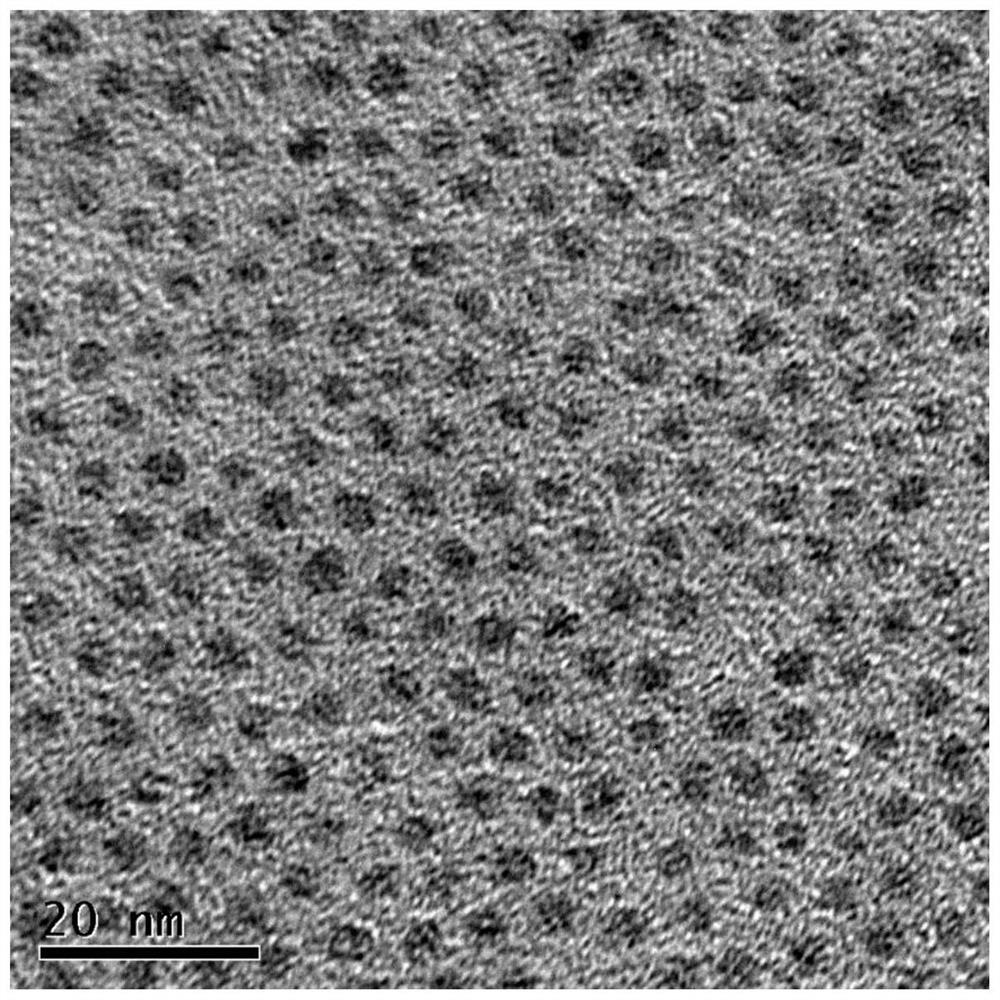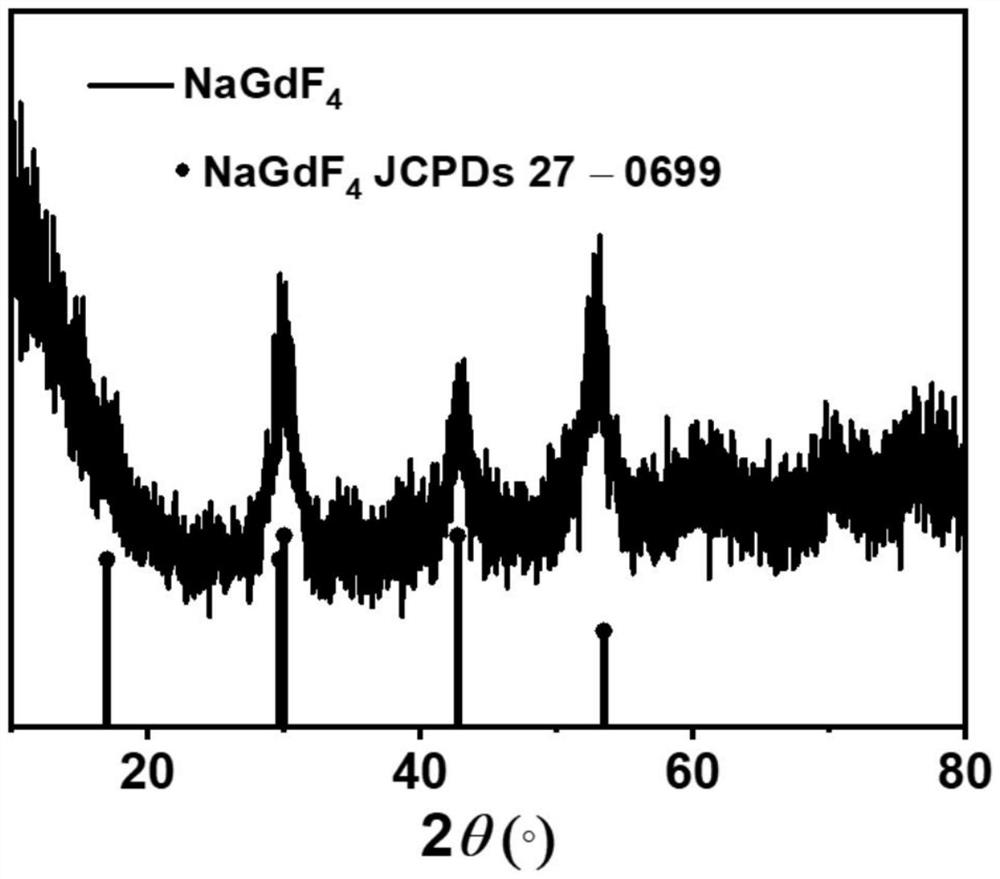Magnetic resonance contrast agent and its preparation and application
A magnetic resonance contrast agent and solvent technology, applied in the field of biomedicine, can solve the problems of inability to detect the lesion area for a long time, ion leakage, low relaxation rate, etc., so as to improve the biological safety in vivo, improve the imaging ability, and the preparation method. simple effect
- Summary
- Abstract
- Description
- Claims
- Application Information
AI Technical Summary
Problems solved by technology
Method used
Image
Examples
Embodiment 1
[0068] Example 1: Preparation of NaGdF 4 nanocrystals
[0069] Dissolve 1.2 g of sodium hydroxide completely in 4 mL of water, add 8 mL of absolute ethanol and 20 mL (or 40 mL) of oleic acid, and stir for 5-10 minutes. 1 mL of an aqueous solution of gadolinium chloride (0.5 mmol) was then added dropwise. After the gadolinium chloride aqueous solution was added dropwise, 4 mL of sodium fluoride aqueous solution (0.5 mmol) was added dropwise to it. After the dropwise addition, the solution was stirred at room temperature for 1 h. After the reaction was completed, it was precipitated with 40 mL of anhydrous ethanol and washed twice to obtain NaGdF. 4 Nanoclusters, reconstituted in cyclohexane.
[0070] Add 6mL oleic acid and 10mL octadecene to a 100mL three-necked flask, and add the prepared NaGdF to the flask 4 Nanocluster solution (0.5 mmol, 2 mL), remove low boiling point solvent (cyclohexane) and oxygen under nitrogen atmosphere, heat up to 260 ° C at 10 ° C / min, then imme...
Embodiment 2
[0071] Example 2: Preparation of OCOPs with different numbers of side chainsn
[0072] The first step: Mix 0.7-7 mmol of OEGMA, 0.2 mmol of CTA-COOH and 0.04 mmol of AIBN and fully dissolve it in 15 mL of 1,4-dioxane, add the mixed solution to a 50 mL Schlenk tube, and put it in a nitrogen atmosphere. Three cycles of freeze-pump-thaw degassing were performed to completely remove oxygen. Subsequently, the Schlenk tube was placed in a 70°C oil bath overnight to react, and then the solvent was evaporated. In the second step, the product of the first step, 0.6-1.8 mmol of OEGMA-OH and 0.04 mmol of AIBN were mixed and fully dissolved in 15 mL of 1,4-dioxane, and the polymerization was carried out in the same steps as the first step. . After the solvent was evaporated, 12 mmol of phosphorus oxychloride was used to replace the hydroxyl group on the side chain of the polymer with phosphate, and then put into a dialysis bag with a molecular weight cut-off of 2 kDA for dialysis to ful...
Embodiment 3
[0077] Example 3: Preparation of OCOP n Coated ultra-small NaGdF 4 Nanocrystals (Gd-OCOP n )
[0078] The ultra-small NaGdF prepared in Example 1 4 Nanocrystals were mixed with nitrous tetrafluoroborate in N,N-dimethylformamide to remove their surface oleic acid ligands, and then mixed with the OCOP prepared in Example 2. n Mix in water at a molar ratio of 1:5, stir overnight at room temperature, then fully evaporate the solvent, add water to the dried product and shake to fully dissolve, and finally remove impurities by ultrafiltration (5400rpm) with an ultrafiltration tube with a molecular weight cut-off of 30kDa. , 3 min) 3 times to fully remove the unwrapped polymer and impurities, put it in a glass bottle and store it at 4 ℃. attached Figure 4-7 for Gd-OCOP n Transmission electron microscopy (Gd-OCOP) 7 : OEGMA 0.8 mmol, OEGMA-OH 0.6 mmol, NaGdF 4 Nanocrystals and OCOP 7 The molar ratio of 5.9:1; Gd-OCOP 10 : OEGMA 1.4 mmol, OEGMA-OH 0.6 mmol, NaGdF 4 Nanocrys...
PUM
| Property | Measurement | Unit |
|---|---|---|
| particle diameter | aaaaa | aaaaa |
| particle size | aaaaa | aaaaa |
Abstract
Description
Claims
Application Information
 Login to View More
Login to View More - R&D
- Intellectual Property
- Life Sciences
- Materials
- Tech Scout
- Unparalleled Data Quality
- Higher Quality Content
- 60% Fewer Hallucinations
Browse by: Latest US Patents, China's latest patents, Technical Efficacy Thesaurus, Application Domain, Technology Topic, Popular Technical Reports.
© 2025 PatSnap. All rights reserved.Legal|Privacy policy|Modern Slavery Act Transparency Statement|Sitemap|About US| Contact US: help@patsnap.com



